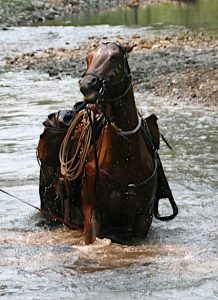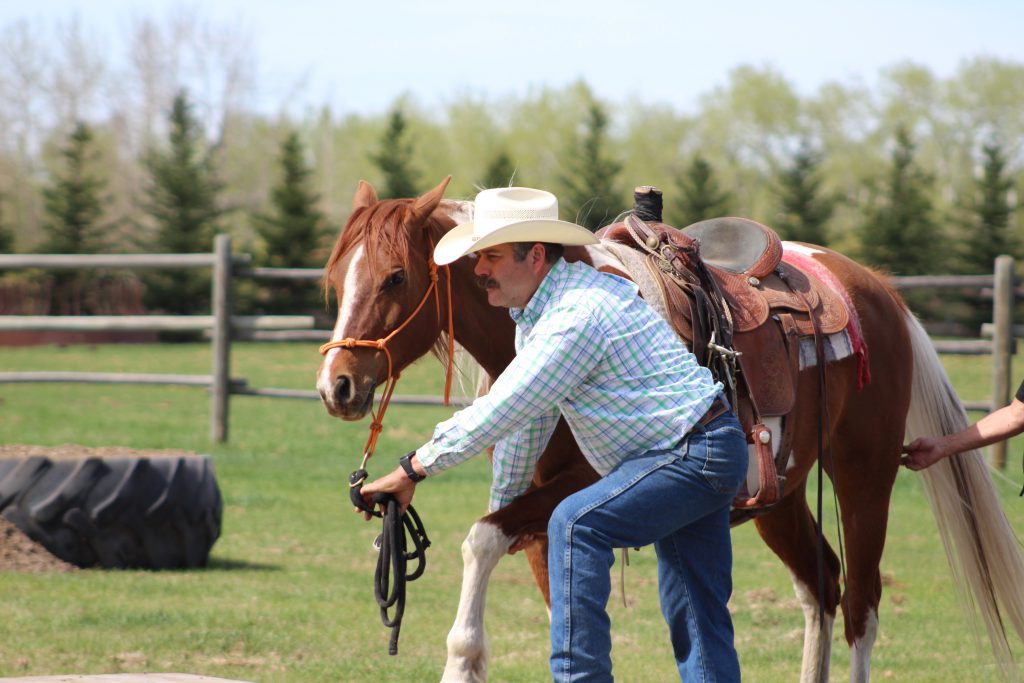A predator, like a cat or a human, is designed to focus on prey and objects in front of them. A prey animal, like a horse, is designed to be attentive to their entire surroundings in order to detect predators. Because of that, there are some important things to know about how a horse’s eyes and ears work. In Part 2 of this series, we’ll touch on the horse’s ears and auditory system.
Our ears (and how our brains process auditory signals) are marvels of evolution that allow us to detect where a sound is coming from in three dimensional space. Our ears however, are fixed forward. A horse’s ears rotate in such a way that they can focus on a sound anywhere without having to turn their head.
The better to hear you with…
What about those ears? A human ear has three muscles for movement. Those allow some of us to wiggle our ears – perhaps a great party trick. You’ll have noticed that a horse can rotate those ears 180°. They have ten muscles to accomplish this, and they can move their ears independently.

This means that a horse can focus on sounds in particular spots without having to turn their head or body. We’re a bit limited here. For a human to pinpoint the source of a sound, we have to turn our whole head left and right.
If that wasn’t enough, a horse can also hear within a greater frequency range (14Hz to 25kHz) than we can. The average audible range for healthy young people is 20Hz to 20kHz. What this means is that horses can hear both lower and higher pitched sounds that we cannot. Just for fun, dogs can hear sounds over 40kHz.
Ear pinning.
Let’s start by clearing up a common misnomer: ear pinning is not when a horse’s ears are turned backwards. A horse can rotate its ears to face directly backward and will do so to listen to sounds behind them. You might notice on a trail ride that a horse in front will generally have it’s ears forward where the horse in the back will tend to have it’s ears backward. That way they’re covering the herd.
An animal (that can) will flatten, or pin, it’s ears back when defending themselves or being aggressive. My personal thought is that this is an instinctive move to protect their ears in a fight. Animals without arms use their teeth to fight. Teeth mean business and those ears sticking out are an easy target. I’m guessing my wild horse, Zeus, wasn’t fast enough getting his ears back one day, because he’s missing a chunk out of his right ear.
When a horse pins its ears, this is not rude, nor is it bad behavior. Ear pinning is simply an expression of what they’re feeling, and nothing more. Think about yourself taking a sniff of a carton of milk that’s gone sour. You’ll make a disgusted face – that’s an expression. It doesn’t mean you’re rude – you’re simply expressing yourself. Therefore punishing a horse because it pins its ears is in no way supportive – helping them with their problem is a much better idea.
Anger and Aggression

When riding, if your horse pins its ears at another horse, I’ve found that the answer is a change of focus: look to a point and then ride to it. Or look forward and ask your horse for a lateral move away from the offending equine. You’ll be helping your horse by providing an alternative – a job – instead thinking about the horse that’s bugging them. This can be important for safety, in case the ear pinning turns into something more, like a follow up kick.
Can a horse get angry? You bet. Although demonstrated anger (ears pinned and teeth bared like a dog) is exceptionally rare, it can happen. Clearly this is not something we strive for because it is synonymous with us causing a breach in trust.
The Importance of Focus
Our horse’s eyes and ears are a great way to observe where their focus is. When riding, you can glance down and see where those eyes and ears are directed. They’ll likely turn their head toward a distraction, just as we would, so their subject of their vision is more observable. The most important piece to take away is that, as leaders, it’s our job to provide a focus for our horse to follow.
Should a horse have their eyes or ears on you all the time? If not, how often? Well, there isn’t a specific duration, but our desire is that we can get the horse’s attention when we need it. Think about it in the context of having a conversation with a friend. If you both stop talking for a while, your thoughts will go in different directions. To get their focus back, you’d start talking again. If your friend was still lost in thought, you’d speak louder. It’s the same with horses. We can use sounds or a touch to bring their focus back to us, and observe the change in their eye or ears.

We desire that a horse follow our focus. If we want a horse’s focus and energy to be on a specific path or movement, our focus must be on that path as well. I’ll use the obstacle course as an example to explain this. Let’s say I want to ride over a platform. In this case my focus and energy must be in a straight line to some distant point on the other side of the platform. Anyone observing will see that my horse’s eyes and ears are on that point. If I err and look down, we’ll likely see the horse’s eyes and ears focus down as well, and my horse will probably stop.
A horse takes in and processes an incredible amount of environmental information. I believe that if a human were exposed to that much, we’d be overwhelmed and confused. Remember that a horse can move both their eyes and ears independently to take in different information. It’s what they instinctively do. That said, there is nothing wrong with a horse looking around when you’re riding. It’s natural and in your best interest. We want to make use of the horse’s acute senses. They can let us know when they perceive something – like a cougar – that our senses can’t detect.
Someone once said that when a horse looks into your eyes, they can see into your soul. I certainly hope so. What I can attest to is that in that moment, we can feel of each other in a very honest and open way. What I want my horse to find in my eye is strength, confidence, trust and pride in him or her – all the things we desire in a true partner.
Scott Phillips
April 2019
